Abstract
Increased vascular permeability characterizes lung injury pulmonary edema and renders fluid balance in the injured lung especially sensitive to changes in hydrostatic pressure. Pulmonary edema is often associated with increased sympathetic nervous system activity which can lead to pulmonary venoconstriction. This postcapillary venoconstriction could raise microvascular pressure and might therefore increase edema in the injured lung. We produced lung injury edema in dogs with oleic acid and directly measured small (less than 2 mm) pulmonary vein pressure. We found that the small pulmonary vein pressure was increased from 9.8 +/- 0.5 mmHg to 12.6 +/- 0.5 mmHg (n = 10) by oleic acid injury edema. The increase was not due to a rise in left atrial pressure since the small pulmonary vein-left atrial pressure gradient also increased. To test if this increase in the postcapillary pressure gradient was sympathetically mediated, we either unilaterally ablated the stellate ganglion or produced unilateral alpha adrenergic blockade with phenoxybenzamine before giving oleic acid. Both of these "antisympathetic" interventions prevented the increase in pulmonary vein pressure caused by oleic acid edema in the protected lung but not in the intact contralateral lung. These interventions produced a 30 +/- 6.8% reduction in the amount of edema caused by oleic acid. Restoring the increase in small vein pressure by inflating a balloon in the left atrium of dogs with bilateral stellate ganglion ablations abolished the reduction in edema produced by antisympathetic treatment. However, the decrease in edema was not significantly correlated with the reduction in pulmonary vein pressure. Thus, the mechanism of the effects of these antisympathetic interventions remains unclear. We conclude that lung injury edema causes sympathetically mediated pulmonary venoconstriction and that antisympathetic interventions significantly reduce lung injury edema and microvascular pressure.
Full text
PDF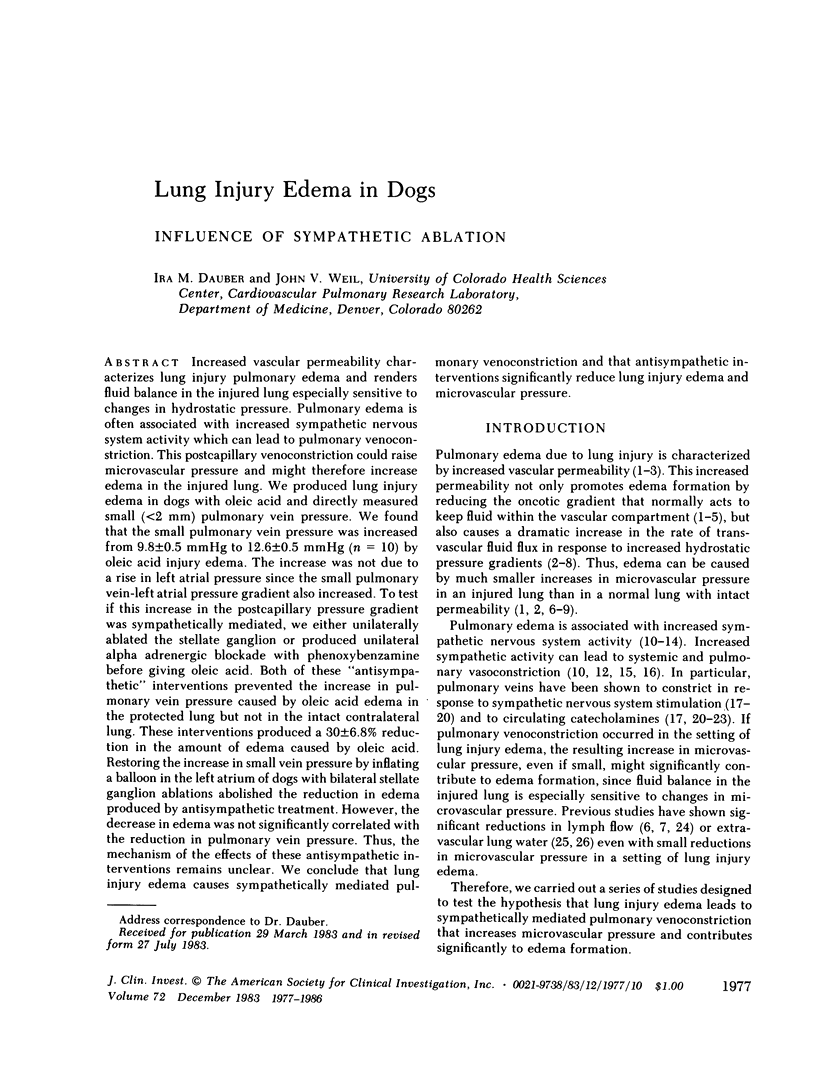
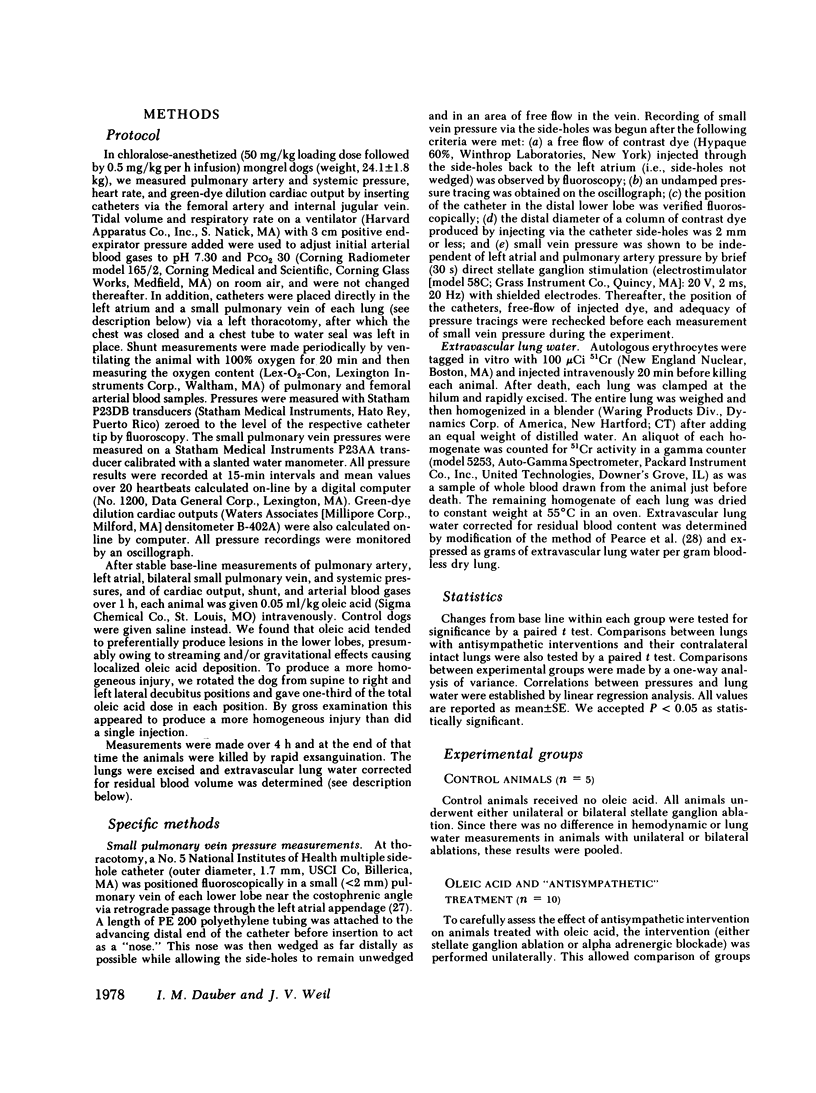
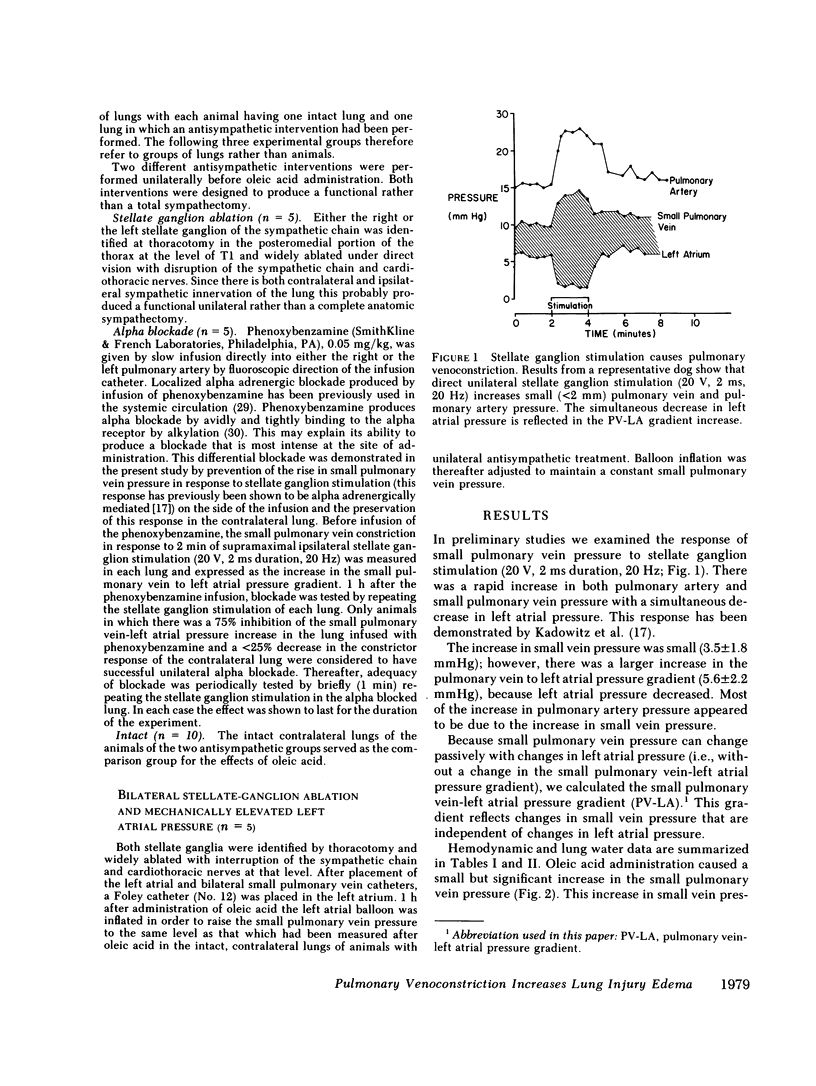
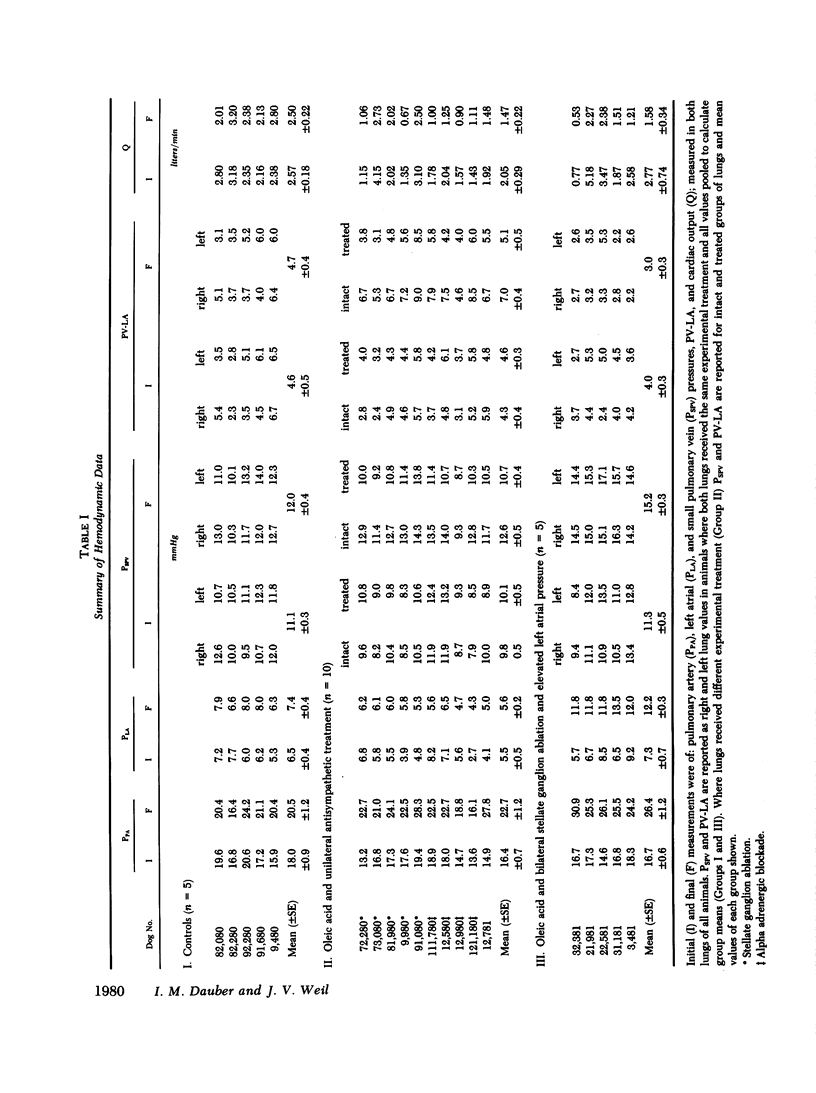
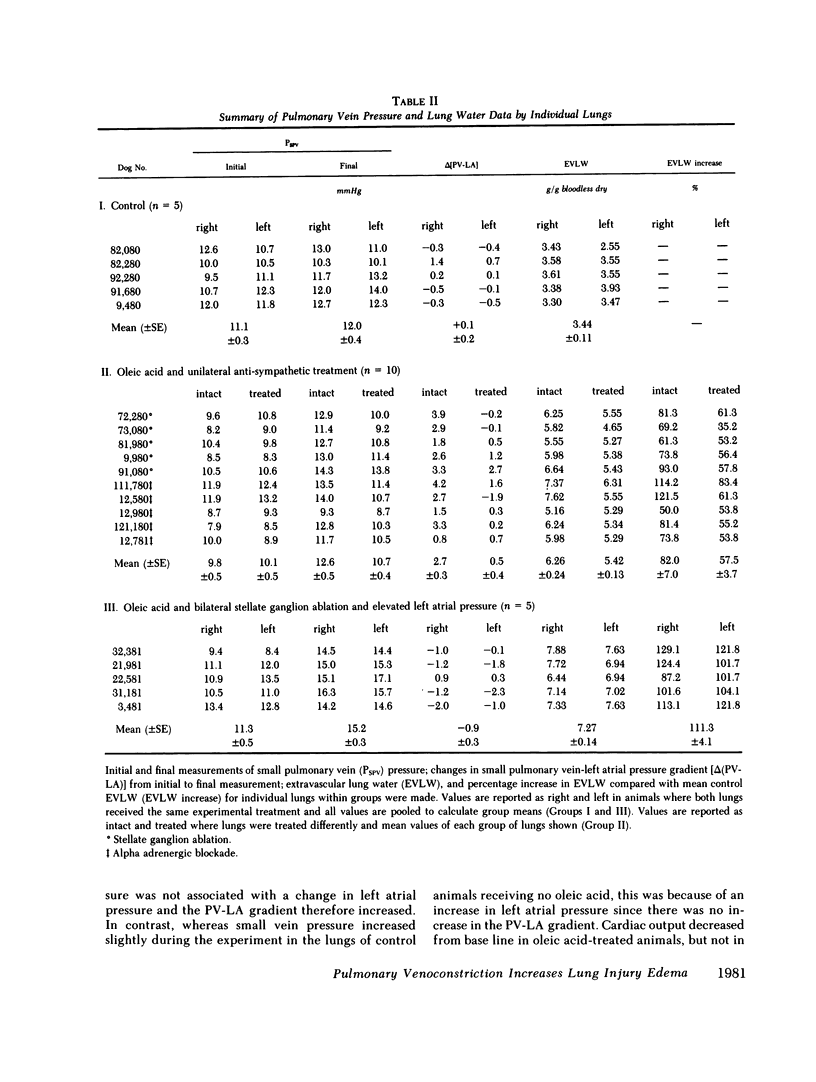
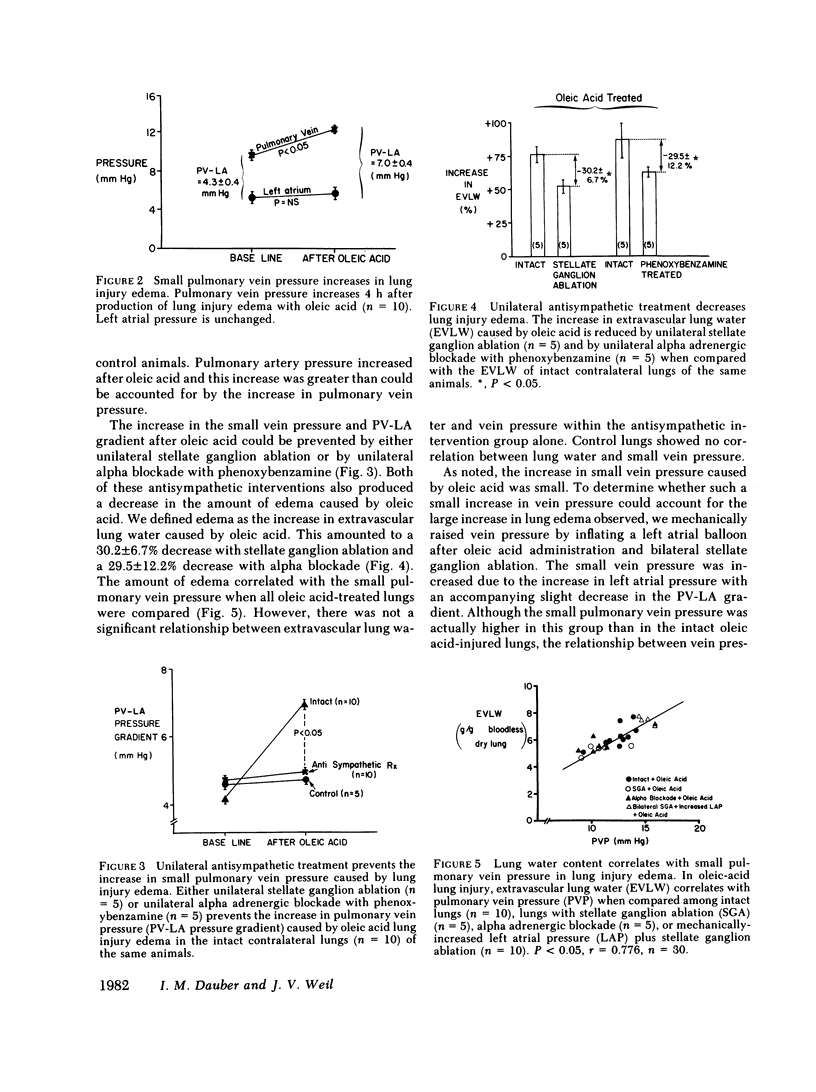
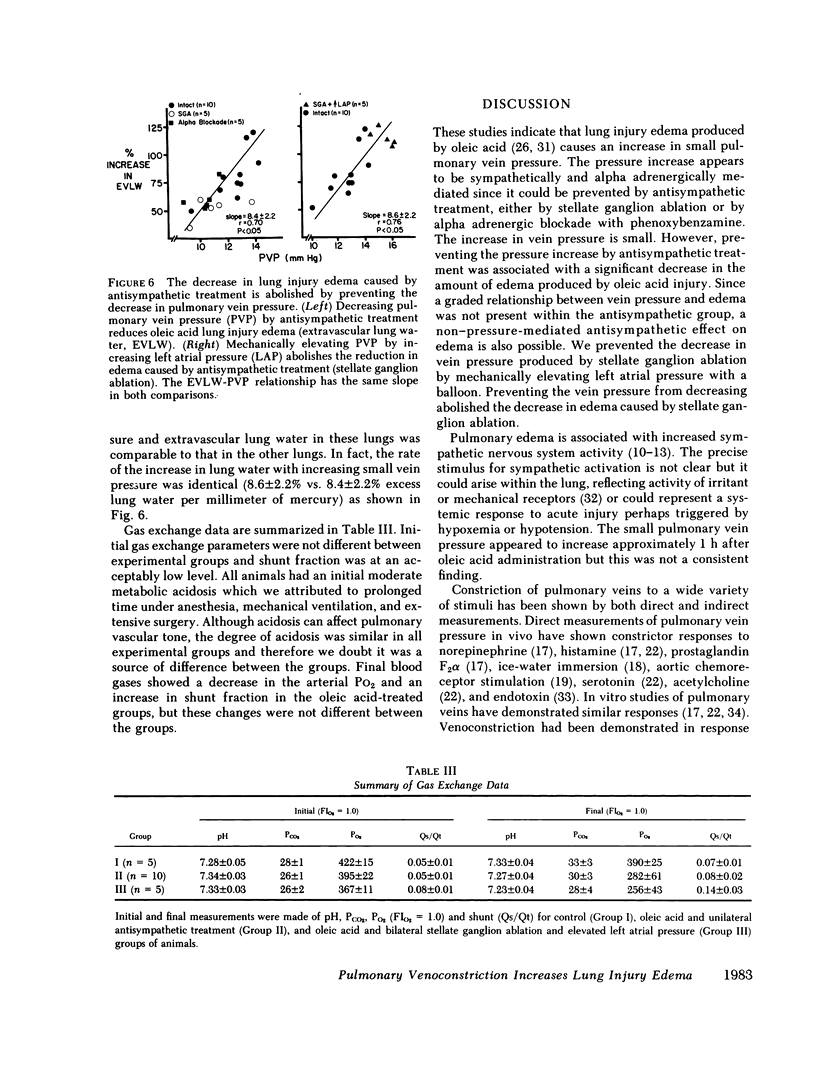
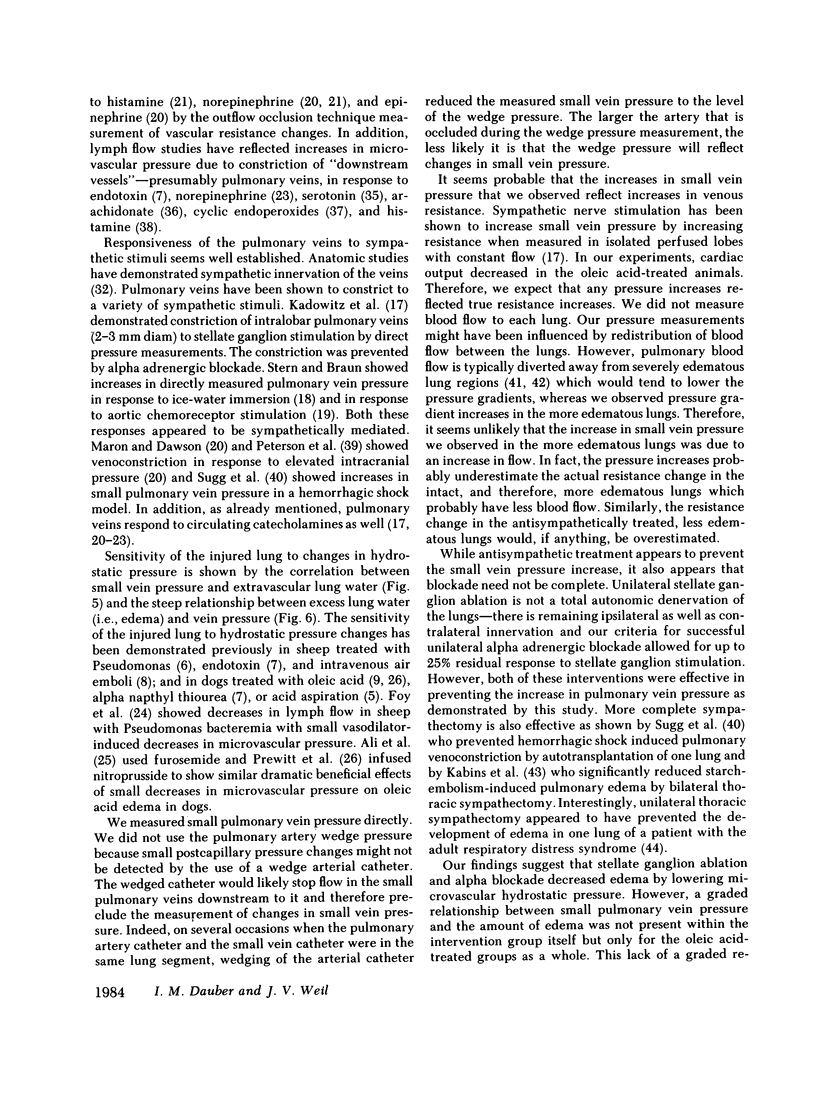
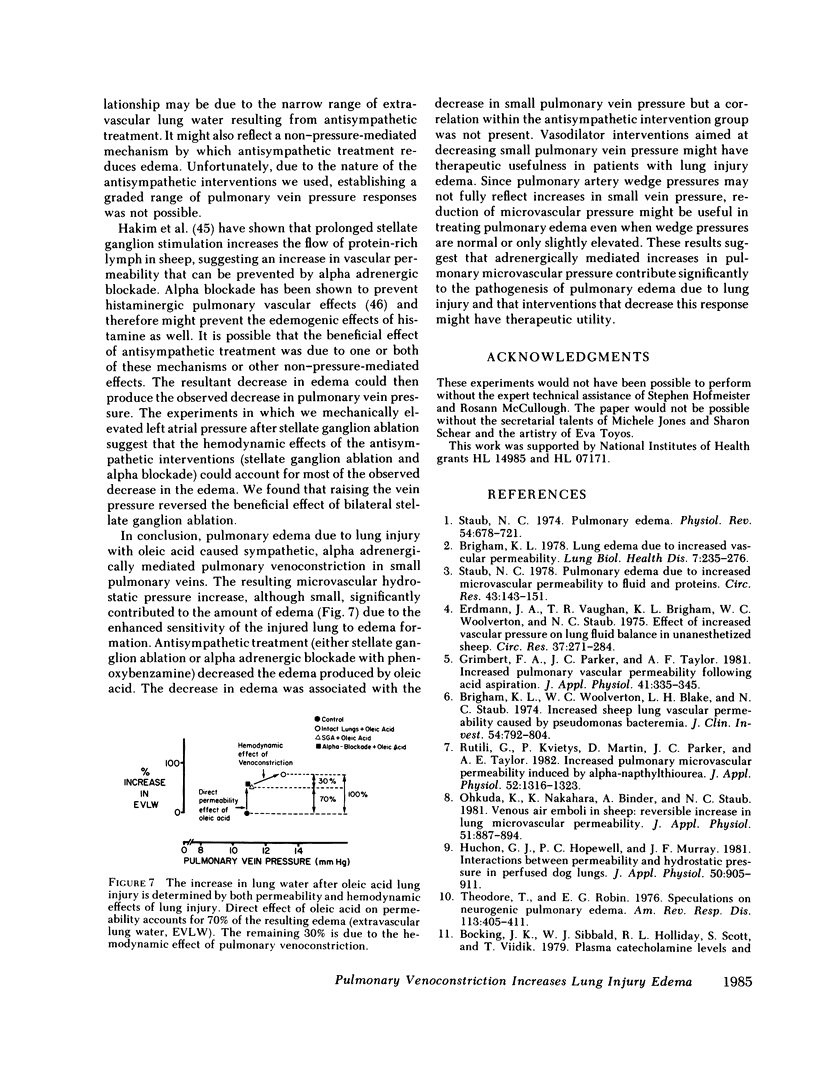
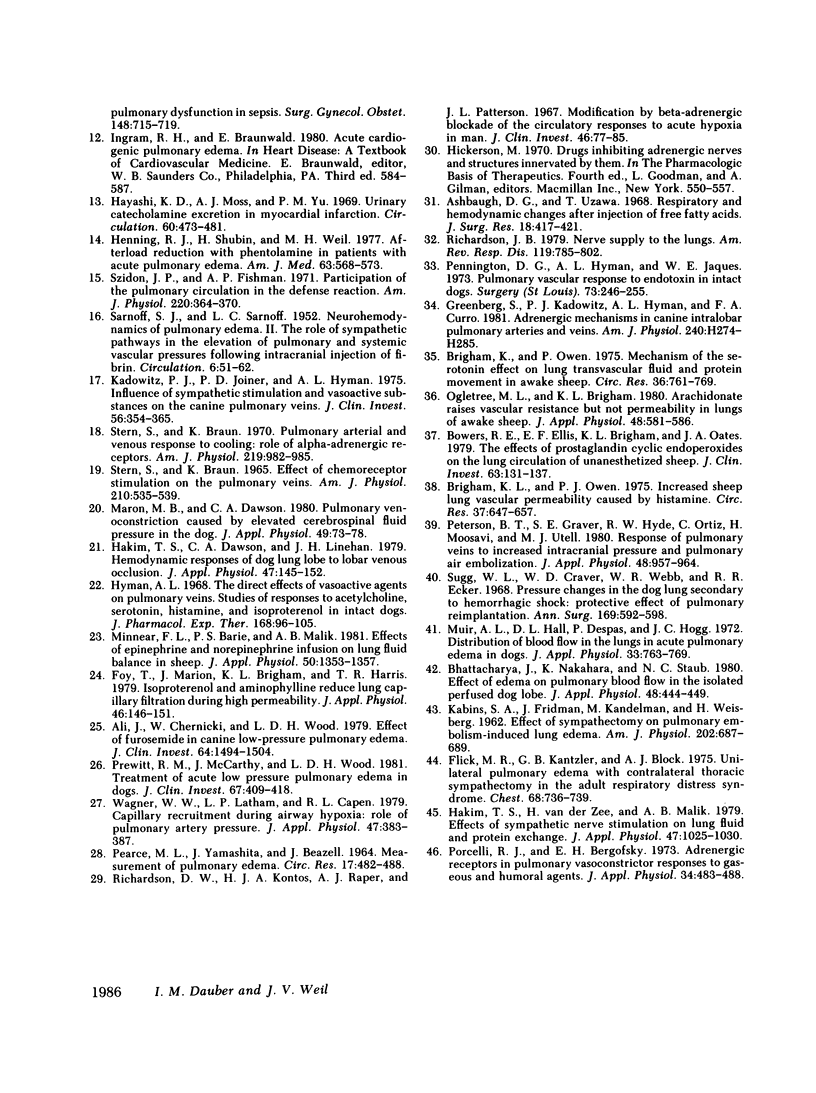
Selected References
These references are in PubMed. This may not be the complete list of references from this article.
- Ali J., Chernicki W., Wood L. D. Effect of furosemide in canine low-pressure pulmonary edema. J Clin Invest. 1979 Nov;64(5):1494–1504. doi: 10.1172/JCI109608. [DOI] [PMC free article] [PubMed] [Google Scholar]
- Ashbaugh D. G., Uzawa T. Respiratory and hemodynamic changes after injection of free fatty acids. J Surg Res. 1968 Sep;8(9):417–423. doi: 10.1016/0022-4804(68)90057-7. [DOI] [PubMed] [Google Scholar]
- Bhattacharya J., Nakahara K., Staub N. C. Effect of edema on pulmonary blood flow in the isolated perfused dog lung lobe. J Appl Physiol Respir Environ Exerc Physiol. 1980 Mar;48(3):444–449. doi: 10.1152/jappl.1980.48.3.444. [DOI] [PubMed] [Google Scholar]
- Bocking J. K., Sibbald W. J., Holliday R. L., Scott S., Viidik T. Plasma catecholamine levels and pulmonary dysfunction in sepsis. Surg Gynecol Obstet. 1979 May;148(5):715–719. [PubMed] [Google Scholar]
- Bowers R. E., Ellis E. F., Brigham K. L., Oates J. A. Effects of prostaglandin cyclic endoperoxides on the lung circulation of unanesthetized sheep. J Clin Invest. 1979 Jan;63(1):131–137. doi: 10.1172/JCI109266. [DOI] [PMC free article] [PubMed] [Google Scholar]
- Brigham K. L., Owen P. J. Increased sheep lung vascular permeability caused by histamine. Circ Res. 1975 Nov;37(5):647–657. doi: 10.1161/01.res.37.5.647. [DOI] [PubMed] [Google Scholar]
- Brigham K. L., Owen P. J. Mechanism of the serotonin effect on lung transvascular fluid and protein movement in awake sheep. Circ Res. 1975 Jun;36(6):761–770. doi: 10.1161/01.res.36.6.761. [DOI] [PubMed] [Google Scholar]
- Brigham K. L., Woolverton W. C., Blake L. H., Staub N. C. Increased sheep lung vascular permeability caused by pseudomonas bacteremia. J Clin Invest. 1974 Oct;54(4):792–804. doi: 10.1172/JCI107819. [DOI] [PMC free article] [PubMed] [Google Scholar]
- Erdmann A. J., 3rd, Vaughan T. R., Jr, Brigham K. L., Woolverton W. C., Staub N. C. Effect of increased vascular pressure on lung fluid balance in unanesthetized sheep. Circ Res. 1975 Sep;37(3):271–284. doi: 10.1161/01.res.37.3.271. [DOI] [PubMed] [Google Scholar]
- Foy T., Marion J., Brigham K. L., Harris T. R. Isoproterenol and aminophylline reduce lung capillary filtration during high permeability. J Appl Physiol Respir Environ Exerc Physiol. 1979 Jan;46(1):146–151. doi: 10.1152/jappl.1979.46.1.146. [DOI] [PubMed] [Google Scholar]
- Greenberg S., Kadowitz P. J., Hyman A., Curron F. A. Adrenergic mechanisms in canine intralobar pulmonary arteries and veins. Am J Physiol. 1981 Feb;240(2):H274–H285. doi: 10.1152/ajpheart.1981.240.2.H274. [DOI] [PubMed] [Google Scholar]
- Grimbert F. A., Parker J. C., Taylor A. E. Increased pulmonary vascular permeability following acid aspiration. J Appl Physiol Respir Environ Exerc Physiol. 1981 Aug;51(2):335–345. doi: 10.1152/jappl.1981.51.2.335. [DOI] [PubMed] [Google Scholar]
- Hakim T. S., Dawson C. A., Linehan J. H. Hemodynamic responses of dog lung lobe to lobar venous occlusion. J Appl Physiol Respir Environ Exerc Physiol. 1979 Jul;47(1):145–152. doi: 10.1152/jappl.1979.47.1.145. [DOI] [PubMed] [Google Scholar]
- Hakim T. S., van der Zee H., Malik A. B. Effects of sympathetic nerve stimulation on lung fluid and protein exchange. J Appl Physiol Respir Environ Exerc Physiol. 1979 Nov;47(5):1025–1030. doi: 10.1152/jappl.1979.47.5.1025. [DOI] [PubMed] [Google Scholar]
- Hayashi K. D., Moss A. J., Yu P. N. Urinary catecholamine excretion in myocardial infarction. Circulation. 1969 Oct;40(4):473–481. doi: 10.1161/01.cir.40.4.473. [DOI] [PubMed] [Google Scholar]
- Henning R. J., Shubin H., Weil M. H. Afterload reduction with phentolamine in patients with acute pulmonary edema. Am J Med. 1977 Oct;63(4):568–573. doi: 10.1016/0002-9343(77)90202-9. [DOI] [PubMed] [Google Scholar]
- Huchon G. J., Hopewell P. C., Murray J. F. Interactions between permeability and hydrostatic pressure in perfused dogs' lungs. J Appl Physiol Respir Environ Exerc Physiol. 1981 Apr;50(4):905–911. doi: 10.1152/jappl.1981.50.4.905. [DOI] [PubMed] [Google Scholar]
- Hyman A. L. The direct effects of vasoactive agents on pulmonary veins. Studies of responses to acetylcholine, serotonin, histamine and isoproterenol in intact dogs. J Pharmacol Exp Ther. 1969 Jul;168(1):96–105. [PubMed] [Google Scholar]
- KABINS S. W., FRIDMAN J., KANDELMAN M., WEISBERG H. Effect of sympathectomy on pulmonary embolism-induced lung edema. Am J Physiol. 1962 Apr;202:687–689. doi: 10.1152/ajplegacy.1962.202.4.687. [DOI] [PubMed] [Google Scholar]
- Kadowitz P. J., Joiner P. D., Hyman A. L. Influence of sympathetic stimulation and vasoactive substances on the canine pulmonary veins. J Clin Invest. 1975 Aug;56(2):354–365. doi: 10.1172/JCI108100. [DOI] [PMC free article] [PubMed] [Google Scholar]
- Maron M. B., Dawson C. A. Pulmonary venoconstriction caused by elevated cerebrospinal fluid pressure in the dog. J Appl Physiol Respir Environ Exerc Physiol. 1980 Jul;49(1):73–78. doi: 10.1152/jappl.1980.49.1.73. [DOI] [PubMed] [Google Scholar]
- Minnear F. L., Barrie P. S., Malik A. B. Effects of epinephrine and norepinephrine infusion on lung fluid balance in sheep. J Appl Physiol Respir Environ Exerc Physiol. 1981 Jun;50(6):1353–1357. doi: 10.1152/jappl.1981.50.6.1353. [DOI] [PubMed] [Google Scholar]
- Muir A. L., Hall D. L., Despas P., Hogg J. C. Distribution of blood flow in the lungs in acute pulmonary edema in dogs. J Appl Physiol. 1972 Dec;33(6):763–769. doi: 10.1152/jappl.1972.33.6.763. [DOI] [PubMed] [Google Scholar]
- Ogletree M. L., Brigham K. L. Arachidonate raises vascular resistance but not permeability in lungs of awake sheep. J Appl Physiol Respir Environ Exerc Physiol. 1980 Apr;48(4):581–586. doi: 10.1152/jappl.1980.48.4.581. [DOI] [PubMed] [Google Scholar]
- Ohkuda K., Nakahara K., Binder A., Staub N. C. Venous air emboli in sheep: reversible increase in lung microvascular permeability. J Appl Physiol Respir Environ Exerc Physiol. 1981 Oct;51(4):887–894. doi: 10.1152/jappl.1981.51.4.887. [DOI] [PubMed] [Google Scholar]
- Pennington D. G., Hyman A. L., Jaques W. E. Pulmonary vascular response to endotoxin in intact dogs. Surgery. 1973 Feb;73(2):246–255. [PubMed] [Google Scholar]
- Peterson B. T., Grauer S. E., Hyde R. W., Ortiz C., Moosavi H., Utell M. J. Response of pulmonary veins to increased intracranial pressure and pulmonary air embolization. J Appl Physiol Respir Environ Exerc Physiol. 1980 Jun;48(6):957–964. doi: 10.1152/jappl.1980.48.6.957. [DOI] [PubMed] [Google Scholar]
- Porcelli R. J., Bergofsky E. H. Adrenergic receptors in pulmonary vasoconstrictor responses to gaseous and humoral agents. J Appl Physiol. 1973 Apr;34(4):483–488. doi: 10.1152/jappl.1973.34.4.483. [DOI] [PubMed] [Google Scholar]
- Prewitt R. M., McCarthy J., Wood L. D. Treatment of acute low pressure pulmonary edema in dogs: relative effects of hydrostatic and oncotic pressure, nitroprusside, and positive end-expiratory pressure. J Clin Invest. 1981 Feb;67(2):409–418. doi: 10.1172/JCI110049. [DOI] [PMC free article] [PubMed] [Google Scholar]
- Richardson D. W., Kontos H. A., Raper A. J., Patterson J. L., Jr Modification by beta-adrenergic blockade of the circulatory respones to acute hypoxia in man. J Clin Invest. 1967 Jan;46(1):77–85. doi: 10.1172/JCI105513. [DOI] [PMC free article] [PubMed] [Google Scholar]
- Richardson J. B. Nerve supply to the lungs. Am Rev Respir Dis. 1979 May;119(5):785–802. doi: 10.1164/arrd.1979.119.5.785. [DOI] [PubMed] [Google Scholar]
- Rutili G., Kvietys P., Martin D., Parker J. C., Taylor A. E. Increased pulmonary microvasuclar permeability induced by alpha-naphthylthiourea. J Appl Physiol Respir Environ Exerc Physiol. 1982 May;52(5):1316–1323. doi: 10.1152/jappl.1982.52.5.1316. [DOI] [PubMed] [Google Scholar]
- SARNOFF S. J., SARNOFF L. C. Neurohemodynamics of pulmonary edema. II. The role of sympathetic pathways in the elevation of pulmonary and stemic vascular pressures following the intracisternal injection of fibrin. Circulation. 1952 Jul;6(1):51–62. doi: 10.1161/01.cir.6.1.51. [DOI] [PubMed] [Google Scholar]
- Staub N. C. Pulmonary edema due to increased microvascular permeability to fluid and protein. Circ Res. 1978 Aug;43(2):143–151. doi: 10.1161/01.res.43.2.143. [DOI] [PubMed] [Google Scholar]
- Staub N. C. Pulmonary edema. Physiol Rev. 1974 Jul;54(3):678–811. doi: 10.1152/physrev.1974.54.3.678. [DOI] [PubMed] [Google Scholar]
- Stern S., Braun K. Effect of chemoreceptor stimulation on the pulmonary veins. Am J Physiol. 1966 Mar;210(3):535–539. doi: 10.1152/ajplegacy.1966.210.3.535. [DOI] [PubMed] [Google Scholar]
- Stern S., Braun K. Pulmonary arterial and venous response to cooling: role of alpha-adrenergic receptors. Am J Physiol. 1970 Oct;219(4):982–985. doi: 10.1152/ajplegacy.1970.219.4.982. [DOI] [PubMed] [Google Scholar]
- Sugg W. L., Craver W. D., Webb W. R., Ecker R. R. Pressure changes in the dog lung secondary to hemorrhagic shock: protective effect of pulmonary reimplantation. Ann Surg. 1969 Apr;169(4):592–598. doi: 10.1097/00000658-196904000-00016. [DOI] [PMC free article] [PubMed] [Google Scholar]
- Szidon J. P., Fishman A. P. Participation of pulmonary circulation in the defense reaction. Am J Physiol. 1971 Feb;220(2):364–370. doi: 10.1152/ajplegacy.1971.220.2.364. [DOI] [PubMed] [Google Scholar]
- Theodore J., Robin E. D. Speculations on neurogenic pulmonary edema (NPE). Am Rev Respir Dis. 1976 Apr;113(4):405–411. doi: 10.1164/arrd.1976.113.4.405. [DOI] [PubMed] [Google Scholar]
- Wagner W. W., Jr, Latham L. P., Capen R. L. Capillary recruitment during airway hypoxia: role of pulmonary artery pressure. J Appl Physiol Respir Environ Exerc Physiol. 1979 Aug;47(2):383–387. doi: 10.1152/jappl.1979.47.2.383. [DOI] [PubMed] [Google Scholar]


